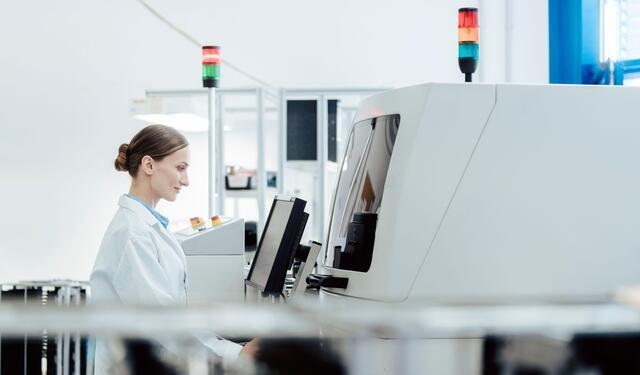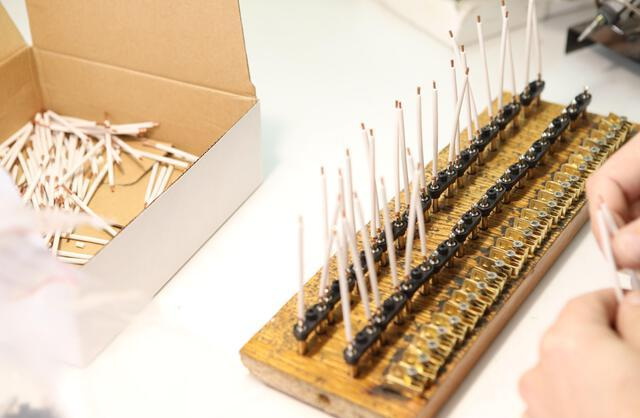Content Menu
● Understanding SMD Machine Air Problems
● Key Factors in Ensuring Optimal Air Flow
>> 1. Proper Temperature and Airflow Speed Regulation
>> 2. Choosing the Right Nozzle
>> 3. Maintaining Consistent Airflow
>> 4. Adjusting Airflow to Component Sensitivity
>> 5. Using Heat Spreaders and Shielding
● Step-by-Step Guide to Optimizing Air Flow in Your SMD Rework Station
>> Step 1: Warm Up the Station
>> Step 2: Select Appropriate Temperature
>> Step 3: Adjust Airflow Speed
>> Step 4: Choose the Correct Nozzle
>> Step 5: Test and Fine-Tune
>> Step 6: Use Protective Measures
● Advanced Tips for Managing Air Flow in SMD Rework Stations
>> Use Airflow Measurement Tools
>> Implement Preheating Techniques
>> Regular Maintenance and Calibration
>> Use Quality Solder Paste and Flux
● Troubleshooting Common SMD Machine Air Problems
● Conclusion
● FAQ
>> 1. What is the ideal airflow speed for microsoldering with a hot air station?
>> 2. How can I prevent components from being displaced by the airflow?
>> 3. What temperature settings are safe for desoldering SMD components?
>> 4. How do I fix low airflow issues in my SMD rework station?
>> 5. Can too much heat damage the PCB during rework?
Surface-Mount Device (SMD) rework stations are essential tools for electronics repair and manufacturing, especially when dealing with delicate SMD components. One of the most critical factors influencing the success of rework operations is optimal air flow. Improper air flow can lead to issues such as component displacement, uneven heating, or damage to the printed circuit board (PCB). This article explores how to ensure optimal air flow in your SMD rework station, addressing common SMD machine air problems, and providing practical guidance for temperature and airflow adjustments.

Understanding SMD Machine Air Problems
Before diving into solutions, it is important to understand the common air-related problems encountered in SMD rework stations:
- Excessive Airflow: High air speed can blow away small components or cause solder splatter, leading to damage or loss of parts.
- Insufficient Airflow: Low airflow may result in uneven heat distribution, causing incomplete solder melting or prolonged heating times.
- Airflow Instability: Fluctuating air pressure or inconsistent airflow can affect the precision of soldering or desoldering.
- Nozzle Blockage or Leakage: Improper nozzle attachment or blockages can reduce effective airflow, impacting performance.
Addressing these issues requires proper adjustment and maintenance of both the air flow and temperature settings on your SMD rework station.
Key Factors in Ensuring Optimal Air Flow
1. Proper Temperature and Airflow Speed Regulation
The temperature and airflow speed are interdependent parameters that must be carefully balanced to achieve optimal results:
- High Temperature & High Airflow: Suitable for large solder joints and heat-resistant components. This setting melts solder quickly but risks damaging nearby components if not controlled properly.
- Medium Temperature & Medium Airflow: Ideal for general-purpose rework on IC chips, diodes, and resistors. It balances heating speed and component safety.
- Low Temperature & Low Airflow: Best for small, sensitive SMD components where precise and gentle heating is required to avoid damage.
Adjusting these parameters according to the specific component and solder joint size is crucial to avoid common air problems such as blowing parts away or uneven heating.
2. Choosing the Right Nozzle
Nozzle selection affects the shape and concentration of the hot air stream. Using a nozzle that matches the size of the component or solder joint helps focus the airflow and heat, reducing the risk of affecting adjacent parts or causing air turbulence that can displace components.
Nozzles come in various shapes and sizes—from narrow, pencil-like tips to wide, flat outlets. For example, a small, round nozzle is ideal for tiny IC pins, while a larger rectangular nozzle suits bigger components or multiple pins. Using the wrong nozzle can cause hot air to spread unnecessarily, increasing the risk of SMD machine air problems such as component movement or uneven heating.
3. Maintaining Consistent Airflow
Regularly check for blockages or leaks in the nozzle and air path. Dust, solder flux residue, or physical damage can obstruct airflow, reducing the efficiency of your rework station. Ensure the nozzle is tightly secured to prevent air leakage, which can reduce effective airflow and cause unstable heating.
Additionally, the air pump or compressor inside the rework station should be serviced periodically to maintain consistent air pressure. Worn-out pumps or damaged hoses can cause fluctuations in airflow, resulting in inconsistent soldering quality.
4. Adjusting Airflow to Component Sensitivity
For very small or delicate SMD components, reduce the airflow to prevent parts from being blown off the board. For larger components or those mounted on large ground planes, higher airflow may be necessary to ensure rapid and even heating.
Understanding the thermal mass of the component and the PCB area it is mounted on is essential. Components with high thermal mass require more heat and airflow to reach solder melting temperature quickly. Conversely, small components with low thermal mass need gentle, controlled airflow to avoid displacement.
5. Using Heat Spreaders and Shielding
In cases where airflow might affect adjacent components, using aluminum foil or heat shields can protect sensitive areas from direct airflow and heat, preventing unintended solder melting or component displacement.
Heat shielding is especially important on densely populated PCBs where components are close together. By isolating the target component with shielding, you can direct airflow more precisely, minimizing SMD machine air problems such as solder bridging or thermal damage to neighboring parts.

Step-by-Step Guide to Optimizing Air Flow in Your SMD Rework Station
Step 1: Warm Up the Station
Turn on your SMD rework station and allow it to reach the desired temperature before starting work. This ensures stable airflow and temperature. Avoid starting work immediately after powering on, as fluctuating temperatures can cause inconsistent airflow and soldering results.
Step 2: Select Appropriate Temperature
Set the temperature slightly above the solder melting point (typically around 350°C for general SMD solder). Avoid excessively high temperatures that could damage components or the PCB. Use a temperature-controlled station to maintain precise heat levels.
Step 3: Adjust Airflow Speed
Start with a medium airflow setting. Observe the solder melting behavior and component stability. Increase airflow if solder melting is slow or decrease if components are moving or being blown away.
The goal is to have a smooth, steady airflow that melts solder without disturbing the component placement. If you notice solder splattering or components shifting, reduce airflow immediately.
Step 4: Choose the Correct Nozzle
Attach a nozzle that focuses the airflow on the target area without affecting surrounding components. Tighten it securely to avoid air leakage.
Using the proper nozzle size and shape helps concentrate heat and airflow, reducing the risk of SMD machine air problems like uneven heating or component displacement.
Step 5: Test and Fine-Tune
Perform a test reflow on a scrap board or small component. Adjust temperature and airflow as needed to achieve smooth solder melting without disturbing components.
Testing helps you find the optimal balance for your specific rework station model, solder type, and component size.
Step 6: Use Protective Measures
Apply heat shields or aluminum foil to protect sensitive nearby components from airflow and heat, especially on dense PCBs.
This step is crucial when working on complex boards with mixed component sizes and thermal sensitivities.
Advanced Tips for Managing Air Flow in SMD Rework Stations
Use Airflow Measurement Tools
Some advanced rework stations come with airflow meters or sensors that help you monitor and adjust the airflow precisely. If your station lacks this feature, consider using external anemometers to measure airflow velocity at the nozzle tip.
Implement Preheating Techniques
Preheating the PCB from the bottom side can reduce the thermal gradient and allow for lower airflow and temperature settings on the rework station. This technique minimizes the risk of SMD machine air problems caused by rapid temperature changes or excessive airflow.
Regular Maintenance and Calibration
Airflow and temperature accuracy degrade over time due to wear and tear. Regularly calibrate your rework station according to manufacturer guidelines. Clean the nozzle and air filters frequently to prevent clogging and airflow reduction.
Use Quality Solder Paste and Flux
High-quality solder paste and flux improve solder flow and reduce the required heating time and airflow intensity. This indirectly helps mitigate SMD machine air problems by enabling gentler heating profiles.
Troubleshooting Common SMD Machine Air Problems
- Low Airflow Despite High Setting: Check nozzle attachment and clean any blockages. Ensure the air pump is functioning correctly.
- Components Being Blown Away: Reduce airflow speed and use smaller nozzles to focus air. Lower temperature if necessary.
- Uneven Heating or Slow Solder Melting: Increase temperature or airflow moderately. Verify the nozzle size is appropriate.
- Airflow Fluctuations: Inspect for leaks or damaged hoses. Replace faulty parts to maintain stable airflow.
- Solder Balling or Splattering: Lower airflow and temperature, and check solder paste quality. Excessive airflow can cause solder to scatter.
Conclusion
Ensuring optimal air flow in your SMD rework station is vital for effective and safe soldering and desoldering of surface-mount components. By carefully regulating temperature and airflow speed, selecting the appropriate nozzle, and protecting sensitive components, you can avoid common SMD machine air problems such as component displacement, uneven heating, and damage to PCBs. Regular maintenance and testing further ensure consistent performance. Mastering these techniques will enhance your rework efficiency and preserve the integrity of your electronic assemblies.
With the right knowledge and practice, you can transform your SMD rework station into a precise, reliable tool that minimizes errors and maximizes repair success.

FAQ
1. What is the ideal airflow speed for microsoldering with a hot air station?
For microsoldering, an airflow speed around 50-60% of the maximum setting is recommended to prevent small components from being blown away while ensuring sufficient heat distribution.
2. How can I prevent components from being displaced by the airflow?
Use lower airflow settings and smaller nozzles focused on the target area. Additionally, use heat shields or aluminum foil to protect adjacent components from direct airflow.
3. What temperature settings are safe for desoldering SMD components?
Generally, temperatures around 350°C are effective for most SMD components. Sensitive parts may require lower temperatures around 300°C, while larger components might need up to 400°C.
4. How do I fix low airflow issues in my SMD rework station?
Check for nozzle blockages, ensure the nozzle is tightly attached, and inspect the air pump and hoses for faults. Cleaning or replacing parts may be necessary.
5. Can too much heat damage the PCB during rework?
Yes, prolonged exposure to high heat or stationary hot air can cause PCB delamination, solder mask damage, or pad detachment. Keep the hot air moving and use appropriate temperature settings to avoid this.




















